The AMD 3rd Gen Ryzen Deep Dive Review: 3700X and 3900X Raising The Bar
by Andrei Frumusanu & Gavin Bonshor on July 7, 2019 9:00 AM EST** = Old results marked were performed with the original BIOS & boost behaviour as published on 7/7.
Power Consumption & Overclocking
Power consumption of the new Ryzen 3900X and 3700X are of particular interest because it’s a very key aspect of the new generation chipsets, and AMD promises some extremely large improvements thanks to the new 7nm process node as well as the optimised chiplet design.
When comparing the single-chiplet Ryzen 3700X to the previous generation Ryzen 2700X, we’re seeing quite some dramatic differences in core power consumption. In particular power consumption at each chip’s respective peak frequency is notably different: Although the new 3700X has a 100MHz higher clock speed and thus is further up the exponential power curve, it manages to showcase 32% lower absolute power than the 2700X.
We have to remember that we’re talking about overall absolute power, and not efficiency of the chip. When taking actual performance into account through the higher clock as well as Zen2’s increased performance per clock, the Performance/W figures for the new 3700X should be significantly higher than its predecessor.
What is curious about the new chip is just how closely it follows its power limitations. The new boosting algorithm on the Ryzen 3 series is a particularly “opportunistic” one that will go as high in frequencies as it can go within its constraints, no matter the amount of CPU cores.
The constraints are as follows:
- Package Power Tracking (PPT): The power threshold that is allowed to be delivered to the socket.
- This is 88W for 65W TDP processors, and 142W for 105W TDP processors.
- Thermal Design Current (TDC): The maximum amount of current delivered by the motherboard’s voltage regulators when under thermally constrained scenarios (high temperatures)
- This is 60A for 65W TDP processors, and 95A for 105W TDP processors.
- Electrical Design Current (EDC): This is the maximum amount of current at any instantaneous short period of time that can be delivered by the motherboard’s voltage regulators.
- This is 90A for 65W TDP processors, and 140A for 105W TDP processors.
Looking at the total power consumption of the new 3700X, the chip is very much seemingly hitting and maintaining the 88W PPT limitations of the default settings, and we’re measuring 90W peak consumption across the package.
When having a closer look at the new Ryzen 9 3900X, first we have to enjoy the sheer amount of cores of this processor!
Following that, we see that this CPU’s per-core peak power consumption is quite notably higher than that of the 3700X, which is not a surprise given that the chip is clocked 200MHz higher at 4.6GHz versus “just” 4.4GHz. However even at this much higher clock, the 3900X’s power consumption remains notably lower than that of the 2700X.
Scaling up in threads as well as cores, we’re seeing a similar scaling behaviour, with the large difference being that the 3900X is maintaining higher power consumption per core (and frequency) than the 3700X. Fully loading the chip we’re seeing 118W power on the CPU cores while the package power is falling in at the exact 142W that AMD describes as the PPT limit of 105W TDP processors such as the 3900X.
Another thing to note in the results between the 3700X results and the 3900X, is that un-core power on the latter is quite higher. This really shouldn’t come as a surprise as the processor has a second chiplet who will have L3 and Infinity Fabric that will use more power.
Graphing the three processors together, we see two main aspects: Again the 3900X and 3700X both consuming notably less power than the 2700X, and the 3700X’s hard limit when reaching the 88W PPT limit while the 3900X is able to scale further up till it hits the 142W limit.

Comparing the full load power characteristics of both SKUs, they end up extremely competitive in both their respective categories. The 3700X’s 90W hard-limit puts it at the very bottom of the CPUs we’ve used in our testing today, which is quite astonishing as the chip is trading blows with the 9700K and 9900K across all of our test workloads, and the latter chip’s power consumption is well over 60% above the 3700X’s.
The 3900X is also impressive given that it’s a 12-core CPU. While posting substantial performance improvements of the 12-core Threadripper counterparts, the 3900X still manages to be significantly less thermally constrained thanks to its much lower power consumption, peaking in at 142W.
The most interesting aspect of AMD’s new opportunistic power boost mechanism lies in a CPU we weren’t able to test today: the Ryzen 7 3800X. At stock behaviour, the chip’s 105W TDP should allow it to behave a lot more like the 3900X when it comes to the higher thread-count frequencies, at least until it maxes out its 8 cores on its single chiplet, which might really put it ahead of the 3700X in terms of multi-threaded performance workloads.
Overclocking: PBO & All-Core
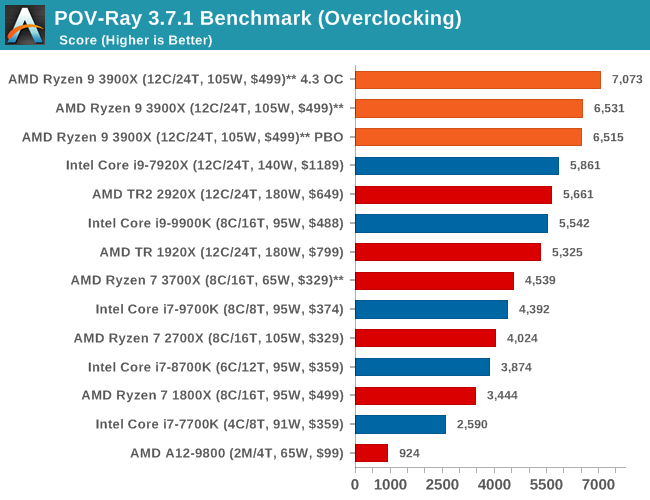
In POV-Ray, running the 3900X at a flat 4.3GHz at 1.35V gives it a 8.2% performance boost over stock. Enabling PBO doesn’t make much difference in multi-threaded workloads for the 3900X as it’s still being limited by the 142W PPT limit.
Unfortunately we weren’t able to further investigate raising the PPT limit for this article due to time contraints as well as currently non-final firmware version for X570 motherboards from the vendors.
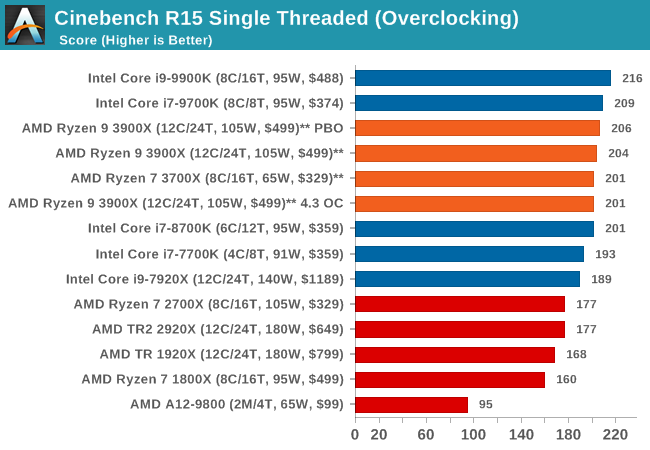
Turning on PBO will increase the single-threaded performance of the 3900X by a few percent, scoring just slightly higher than the stock settings. Naturally the 4.3 GHz flat overclock will regress in performance as it loses out 300MHz peak frequency compared to stock.

Finally, a Cinebench R15 MT run shows similar multi-threaded behaviour, with the 4.3GHz flat overclock achieving a 9.2% better score, whilst the PBO overclock isn’t able to further increase frequencies beyond the default power limits of the chip.



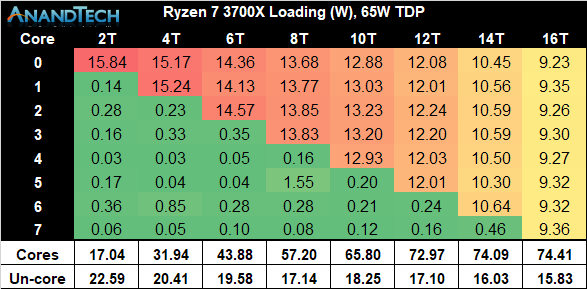
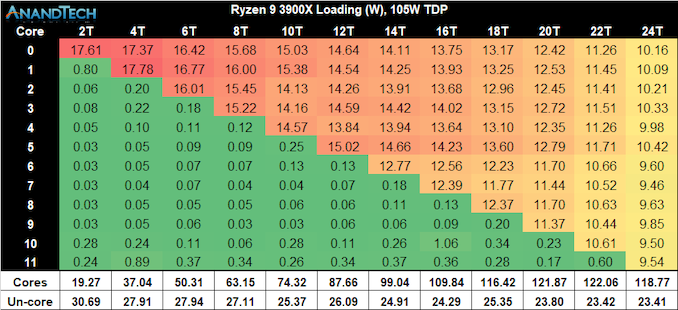
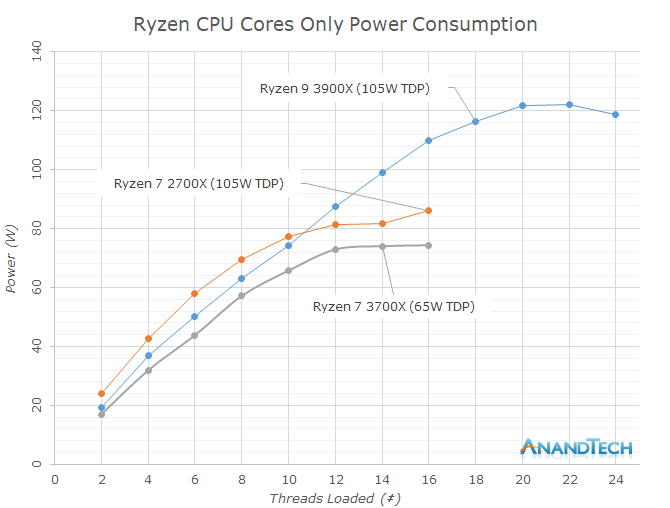








447 Comments
View All Comments
Maxiking - Tuesday, July 23, 2019 - link
LOOOOOOL, so we have a guy confirming AMD doing fraund by misleading people about the frequency, instead of acknowledging the fraund, we gonna talk about semantics.Yeah, if you get sentenced for a sexual assault, you should sue then anyone who has accussed you of raping. Just wow.
Brilliant logic, sir.
Maxiking - Tuesday, July 23, 2019 - link
*fraudQasar - Tuesday, July 23, 2019 - link
still valid there buddy.. like has been said, you are the only one throwing the word fraud around, and that amd should be sued over this. so what everMaxiking - Tuesday, July 23, 2019 - link
And again... let me copy paste."You are uneducated, TDP doesn't mean power consumption or the highest peak but the amount of heat dissipated, it informs you how much of heat the cooler must be able to dissipate in order to keep the cpu cool enough to run.
Get it? 1700x TDP was 95W yet there were tasks it managed to consume 120 or even 140w on stock settings. Like do you even watch reviews? It was the same with 2700x.
but mimimimimimi AMD good mimimimimi Intel bad"
Korguz - Tuesday, July 23, 2019 - link
and yet, you still refuse to admit, that intel has its own issues with fraud and misleading its own customers.does he actually say its fraud ?? not directly, seems only YOU keep saying that, and only YOU say amd should be sued for it. again.., i would love to see YOU file a suit against amd for it, considering you are so hung up about it but you wont, cause you are all talk, no action, and probably know.. you wouldnt get very far with that law suit
Maxiking - Tuesday, July 23, 2019 - link
I said a few times... I don't tend to buy amd products so no, I am not gonna sue anybody.And as pointed out in the video, in his German one, he works for a retailer selling prebuilt pcs.. People keep returning pcs with AMD cpus becaue they do not boost to the promised frequency. You there, there are something like laws, if you write on the box 4.6ghz, it must reach it.
You are so knowledgeable, sharp minded and analytical when comes to meaning of words and what people want to say, you should sue Intel on your own, should be easy.
Korguz - Tuesday, July 23, 2019 - link
why not ?? going by how dead set you are about this.. seems like it would be an easy win for you.. ooooohhhh in the german one.. i understand now.. too bad i dont speak german so i cant confirm this... and if some one writes on the box that something uses a certain amount of power.. then it should use it.. not 50 to 100 watts more.. i have a few friends that buy intels cpus.. they see it uses 95 watts of power.. so they get a HSF that can dissipate that much power.. then wonder why their cpu throttles and runs slow when under load... then i point then to the link i just posted,and they are not happy.. and now need to go buy yet another HSF to handle the extra power.You are so knowledgeable, sharp minded and analytical when comes to meaning of words and what people want to say, you should sue Amd on your own, should be easy. again, too bad you wont.. cause you are all talk. have a good day sir..
Maxiking - Thursday, July 25, 2019 - link
Again, you have once again showed your AMD fanboyism.There is written: TDP 95W. I already explained what TDP means. AMD's TDP isn't accurate either.
AMD has 4.6ghz on the box whilst a bing number cpus does not REACH IT AT ALL. There is no "*" moniker next the 4.6ghz claim and they do not say that their cpu may not reach the frequency at all. In fact, there is a video from AMD on youtube promised even higher frequency, lol. Up to 4.75 ghz.
So yeah, stop being desperate and forcing Intel into the debate.
Because your childish attempts are futile, this is not about AMD or Intel. It is about us consumers. What will be next? 6 Ghz on the box?
Maxiking - Thursday, July 25, 2019 - link
AMD has 4.6ghz on the box whlist a big number of cpus do not REACH IT AT ALL under any load, conditions. Typing on phone is just cancer.Korguz - Thursday, July 25, 2019 - link
and again, like in another thread, you showed how much you hate amd, and are biased against them, and you call me an amd fanboy, you are just as much an intel fanboy. FYI, IF you actually READ the link i posted, you would see that intels 95 watts, is pretty much a MINIMUM their chips use, in reality, its more like 50 to 100 ABOVE that, and also.. amd is A LOT closer then intel is to the TDP they state, but again.. to be fair, amd AND intel use and come do different values for TDP, but you cant see passed your hated for amd to see this.. you are the one that has to resort to name calling, so WHO is being childish ?? what wil be next, intel claiming their cpus use 100 watts, but in reality, they use 300 ?